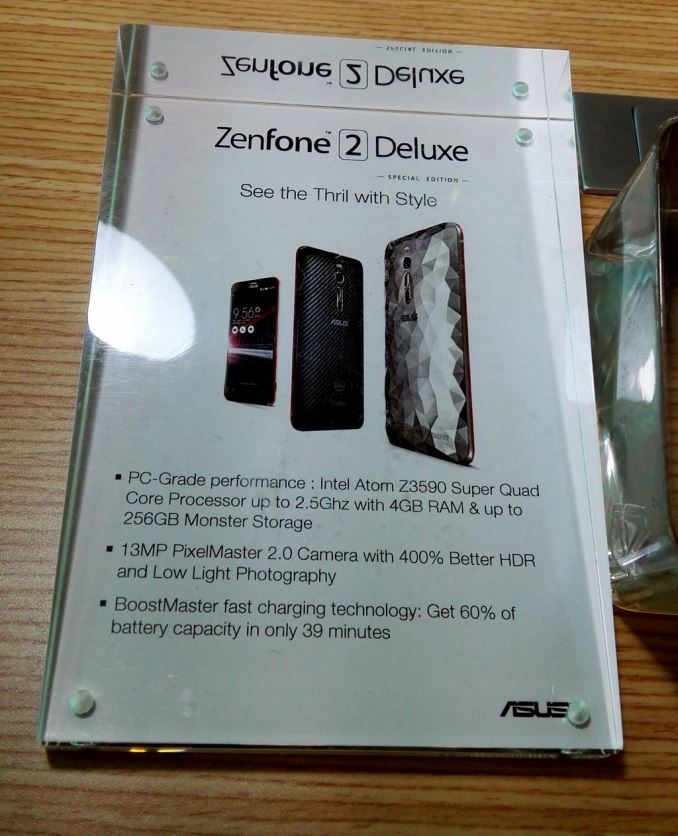ASUS Booth Tour at CES 2016: 10G Switches, External GPU Dock, USB-C Monitor and more
by Ian Cutress on January 19, 2016 9:00 AM ESTASUS ZenFone 2 Deluxe Special Edition
If you caught our review of the CUBOT H1 smartphone, you may have read the paragraph where I (Ian) was interested in the ZenFone 2 for a long time as a potential upgrade device from the HTC One max. When the ZF2 was announced, at $200 for 2GB/16GB with a quad core Bay Trail-based Atom processor and 5.5-inch 1080p screen with dual-SIM functionality, I was certainly interested. Unfortunately, the availability of the 128 GB ZenFone 2 Deluxe model was spotty outside of India and Brazil at best, and even here in the UK my attempts to purchase the right model for a family member ended up in the Chinese version being delivered. Fast forward a few months, and it turns out there is a reason why the 128 GB model didn’t have a big reach – ASUS is now producing an even higher up model.
The ZenFone 2 Deluxe now gets the Special Edition treatment, featuring a more powerful processor in the Z3590 (quad core, up to 2.5 GHz) as well as 256 GB of storage. The 4 GB of DRAM and other specifications stay the same, with the same color styles as the ZF2 Deluxe, but I’m pretty sure that most users will never need more storage in their phone after this, negating the need for a micro-SD card.
Prices and dates were not said, though I’d imagine this to be north of $350 when it hits the shelves. There was another model next to it for which I forgot to take pictures, called the ZenFone 2 Max, which a larger 5000 mAh battery but Snapdragon 410 and only a 720p screen. I’m all for larger batteries, and this one sounds like a direct competitor to my CUBOT. GSMArena has the device listed as due on shelves in January.














50 Comments
View All Comments
WhisperingEye - Wednesday, January 20, 2016 - link
Panzerknacker- I don't understand why you replied to a phone question with a router question.Xajel - Sunday, January 24, 2016 - link
The main reason behind this is that most consumer devices hardly sustain the 1Gb connection.. only some extreme consumers like heavy media servers at home that serves multi 4K stream...so for a consumer, 1Gb is enough, and there's no devices that can make use of 10Gb for the consumer...
Some advanced/enthusiast users uses a Link Aggregation connection as a backbone of their network ( NAS -> Switch <- HTPC/Main PC ) so these can serve multi streams in the same time without any drops... but that is rare as 1Gb is enough for most users already...
Maybe pro users, like pro video editing needs these 10Gb links, but it's already rare situation to see this in a home user, a person with the need for 10Gb ethernet is already using high-end workstations with professional systems.. so it's not a consumer oriented product any more...
Personally I thought about having 10Gb as a backbone for my home network just to be future proof.. but after looking again.. I found it too expensive, and I can make 2x 1Gb Link Aggregation which much less cost and still serve me well for few years a head ( NAS + HTPC + router + Switch all with LA connections )
Lieuchikaka - Thursday, June 2, 2016 - link
http://mavangvn.vn/ma-vang-dien-thoai/dien-thoai-s...Lieuchikaka - Thursday, June 2, 2016 - link
http://mavangvn.vn/ma-vang-dien-thoai/dien-thoai-s...rhx123 - Tuesday, January 19, 2016 - link
Using their own standard instead of TB3 just screams of Vendor Lock-In, especially when TB3 can do 36gbps over an active cable.SirKnobsworth - Tuesday, January 19, 2016 - link
According to Tom's, they actually require 2 type C cables too.Alexvrb - Tuesday, January 19, 2016 - link
Your statement is ironic to me because thunderbolt is itself... a proprietary standard. For external graphics we really need a standardized "Type G" port or something that can provide all the bandwidth by itself. But that will probably never happen. For that matter, even a much tamer enclosure hosting "only" up to 150W GPUs would still be a huge boost for a laptop.nathanddrews - Tuesday, January 19, 2016 - link
So... what are the implications of USB-C displacing HDMI and DisplayPort connectors? I know that it technically is DP over alternate mode, but it's clearly very popular. It seems like many new displays have it built in. Adaptive Sync? Latency? Would there be a penalty of some kind for sending video output through the USB bus instead of directly from the GPU?My only experience is with a first-generation USB display that sucked immense balls.
SirKnobsworth - Tuesday, January 19, 2016 - link
It's just a multiplexer that sends the signal over unused pins. You only get two lanes (as opposed to the usual 4), but that's fine as long as you don't need 4k60.Ryan Smith - Tuesday, January 19, 2016 - link
You can get 4 lanes of DP. It just uses up all the differential pairs, so you have to give up USB 3.x to get it (which is why DP 1.3 is going to be such a big deal).